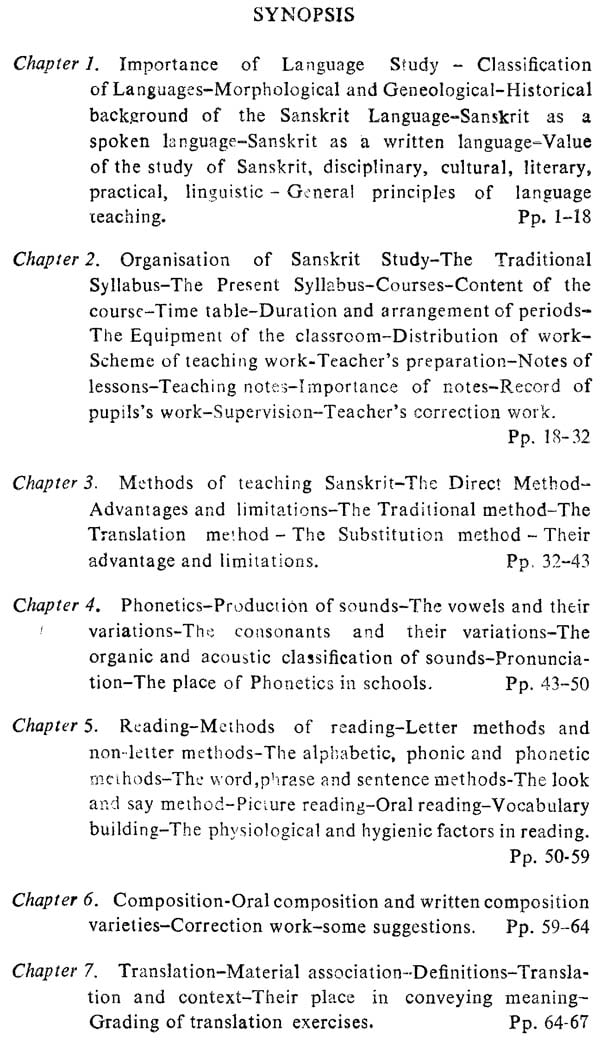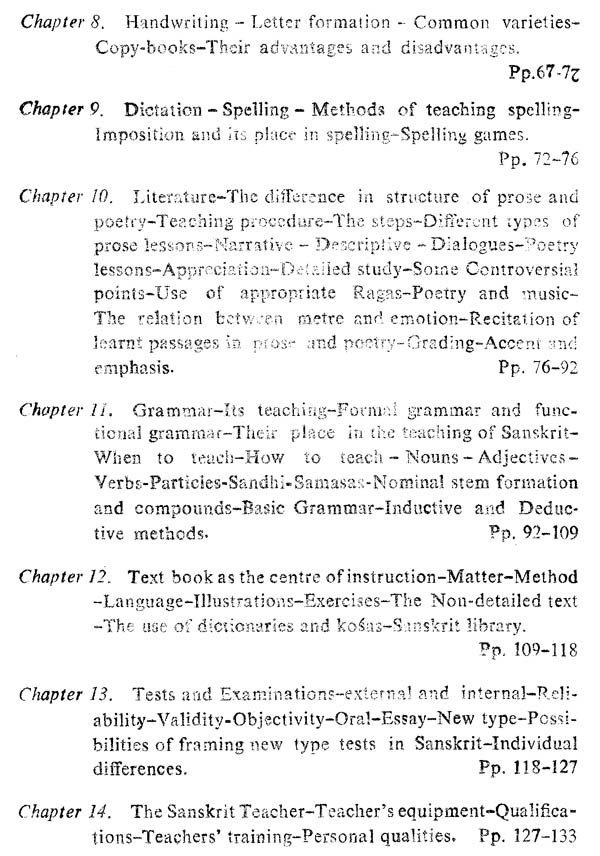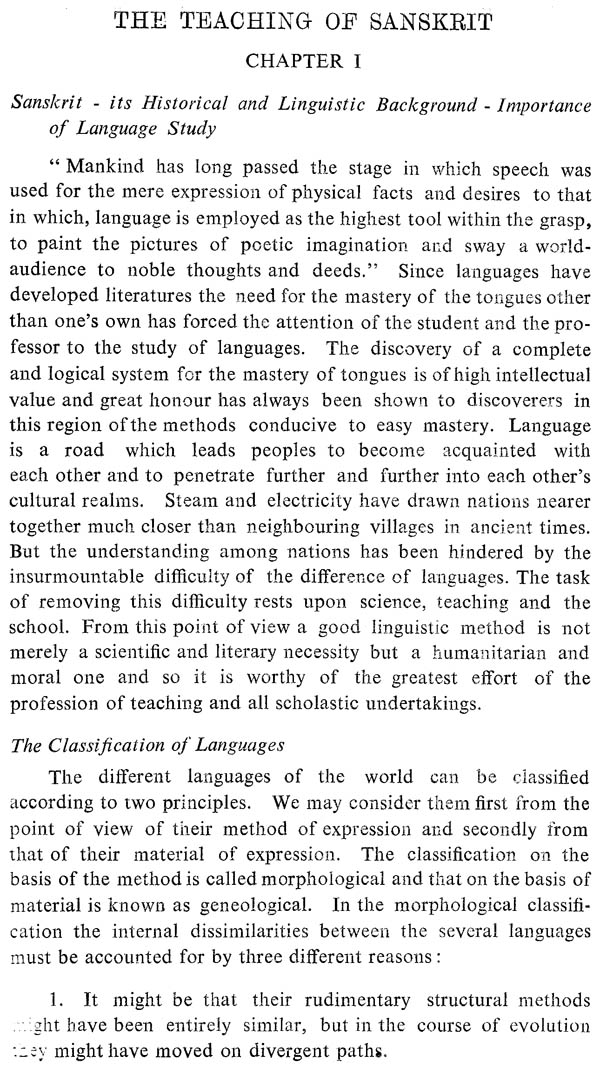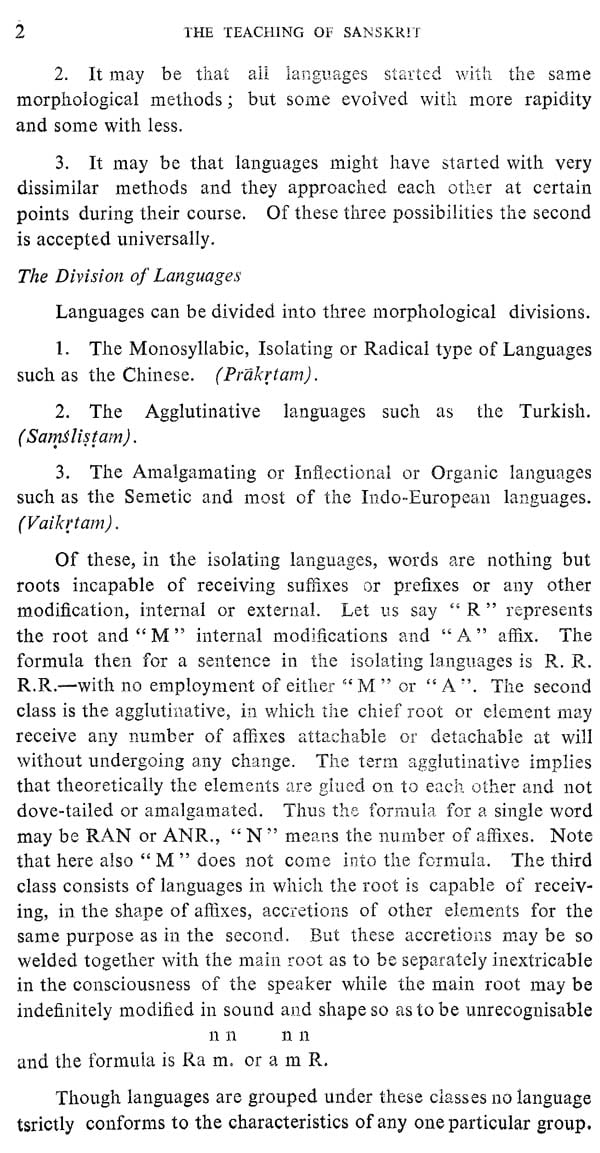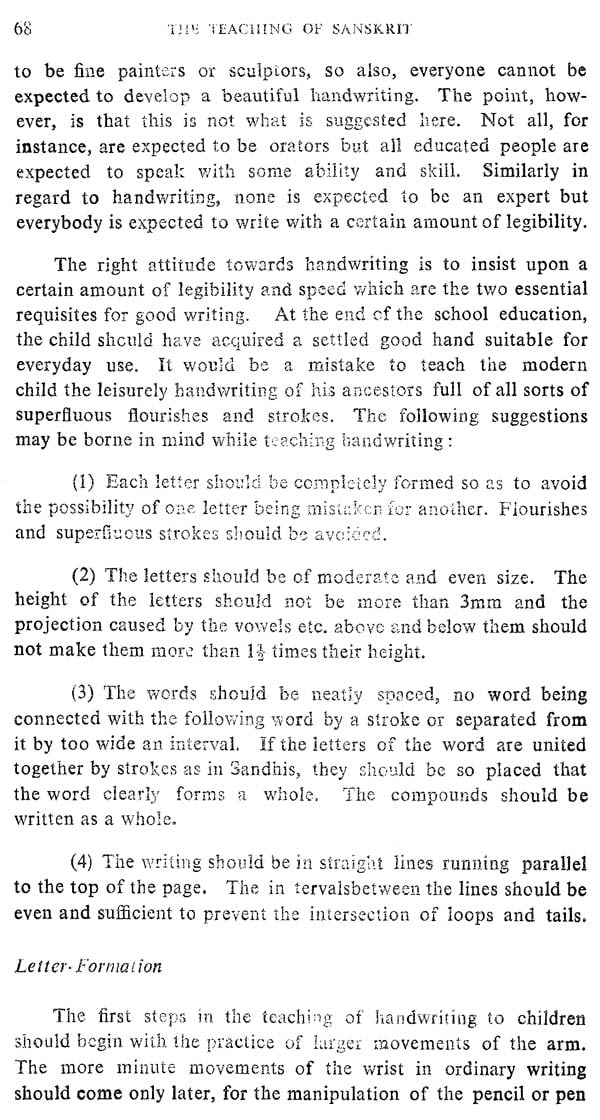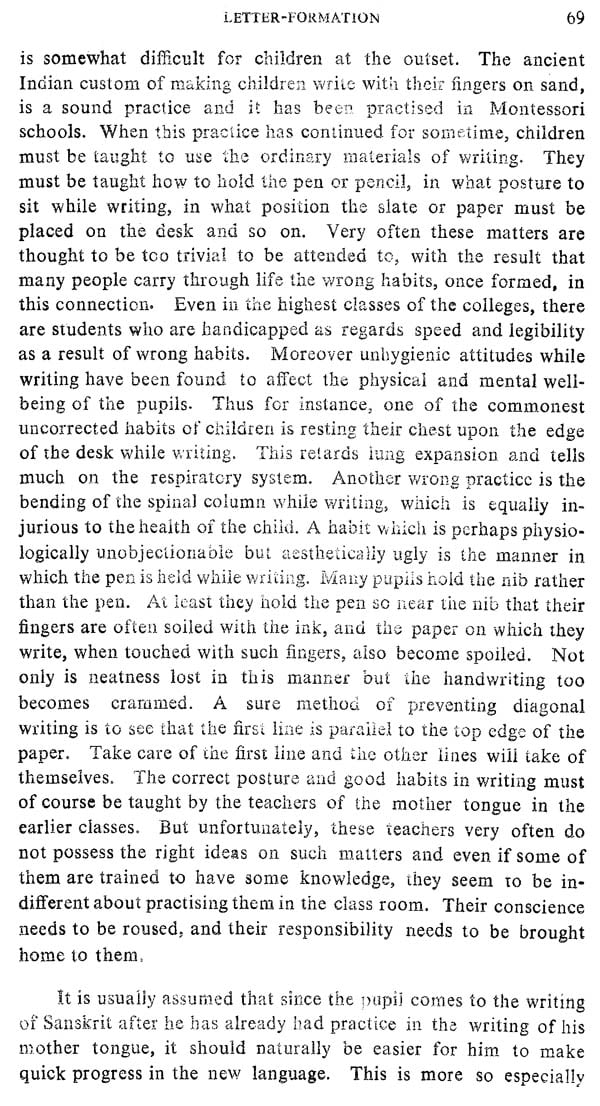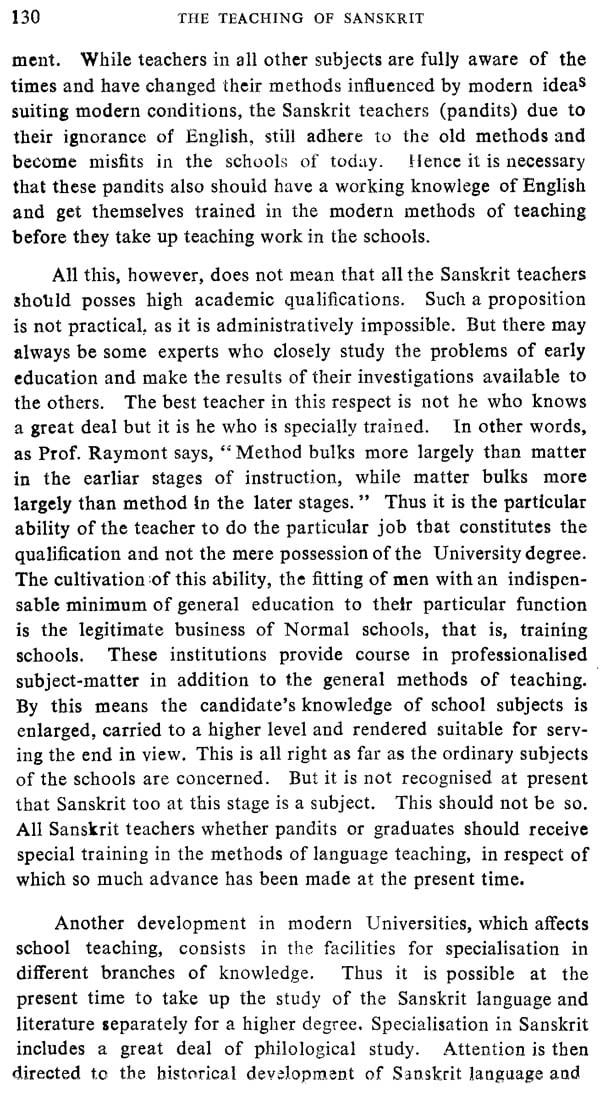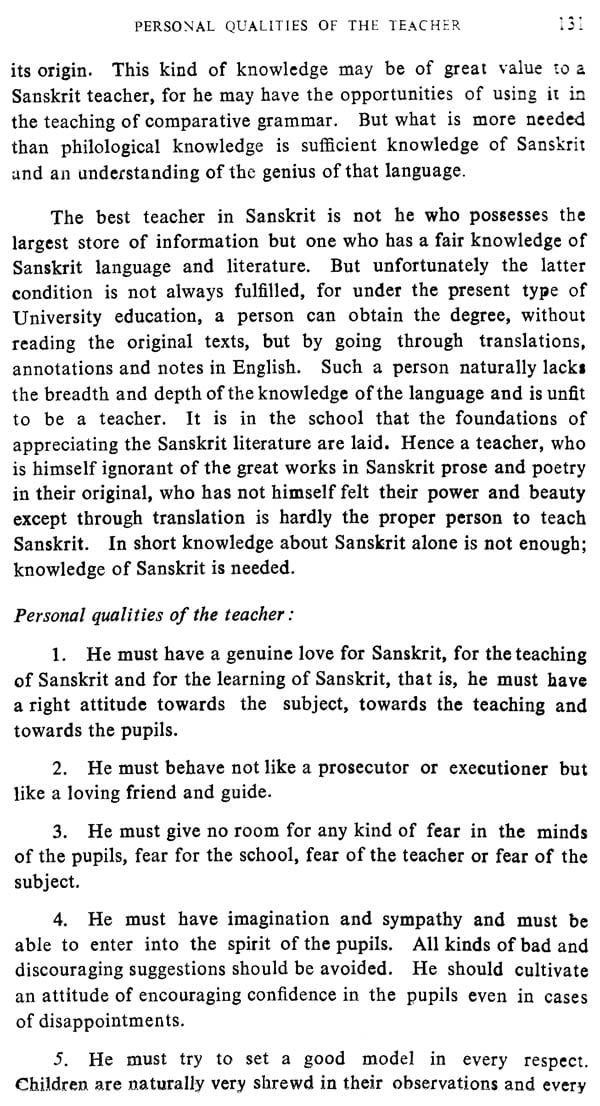
The teaching of Sanskrit (An Old and Rare Book)
Book Specification
| Item Code: | NZW550 |
| Author: | Prof. K. Rama Varma Raja |
| Publisher: | THE SAMSKRIT EDUCATION SOCIETY (REGD.) |
| Language: | ENGLISH |
| Edition: | 1965 |
| Pages: | 136 |
| Cover: | PAPERBACK |
| Other Details | 9.50 X 6.50 inch |
| Weight | 210 gm |
Book Description
Feeling, as many of us do, that the study of Sanskrit has been unduly neglected in recent years and that a false idea has been encouraged that it is a difficult or dead language, I welcome every‘attempt to popularise the teaching of Sanskrit on right lines, and as justly pointed out by Dr. Raghavan in his Preface, the traditional practices and the teaching resources available in Sanskrit literature can be adapted and utilised with advantage at present.
Professor K. Rama Varma Raja, the author of this valuble brochure, has combined with his hereditary love for and study of Sanskrit, a knowledge cf comparative philology and the pedagogic practice in many covniries besides our own. After attempting a classification of Janguages and emphasising the peculiar factors in favour of Sanskri!, he urges that Sanskrit should play a role equal to thet of English both as a spoken and as a written language. He points out that, from the earliest days, Sanskrit knowledge was as widespread in the South as in the North and draws attention to the fact that the great grammarian Katyayana, who flourished in the third century B.C., was a southerner. Sanskrit, according to him, covers a vast field of racial inheritance; and,in addition, it 1s noteworthy that India was the original home of the science of language which successive grammarians and | philosophers brought to perfection. It was, in fact, through the study of Sanskrit that the modern science of comparative philology was inaugurated by Bopp, Max Muller, Brugmann and others.
The author insists that students of Sanskrit should acquire a preliminary grounding in their mother tongue. He observes that thoroughness rather than variety was the characteristic of the traditional syllabus whereas, at present, variety is aimed at rather than thoroughness. As a teacher of long standing, he goes into the details of the syllabus, time table and so forth and he devotes Chapter 3 to the various methods of teaching Sanskrit, namely, the direct and the synthetic methods with their emphasis on speech, and the traditional method. He also deals with what he calls the translation method and the substitution method which last is based on a model sentence. The author deals successively with phonetics and with the basis and methods of reading, composition and translation. He devotes special attention to the inculcation of literature by prose or poetry lessons and he makes some interesting remarks on the use of appropriate Ragas in reading and recitation.
Readers of this volume will be specially grateful to Professor Rama Varma Raja for his very appropriate insistence on the importance of teaching grammar which has been neglected of late.
**Contents and Sample Pages**
Sanskrit had evolved methods of learning which were effective and productive of admirable results in its heyday. The old system succeeded in giving mastery and eloquence and in fostering originality and creativity, and neither versatile scholars who became proficient in diverse branches nor prodigies at young age were rare phenomena. But in modern times the multiplicity of languages and subjects to be learnt at school and college, the increase in the number and the nature of the people who desire to study Sanskrit, the change in the aim and content of Sanskrit education, the dissipation of the strong atmosphere of Sanskrit which influenced the ear and the eye, all these factors have made it necessary to bestow thought on the problems of teaching this language in modern educational] institutions and to evolve methods suitable to and fruitful in the altered situation of today. The perpetuation of the old method had contributed to the perpetua- tion of the idea that Sanskrit is a difficult language and to the general decline in the interest to learn it. The coming together of the peoples of the world and the need to learn foreign languages, as well as languages of culture, have led to investiga- tions and experiments in the techniques of teaching languages and the teaching of Sanskrit alone could not stand aloof from all this ferment of thought in the field of language teaching.
Sanskrit is unique in its nature, being neither dead like Greek nor alive like a mother-tongue. As the classical language of the country and the language of its culture, Sanskrit, with its ideas and words, has permeated all the spoken languages, a circumstance which facilitates its study. In fact, for long, Sanskrit and the local language were together studied, in the same local script, and one esteemed as a local scholar was always erudite in both Sanskrit and the local language. Because of this and other factors, Sanskrit calls for its own approach towards its teaching problems. In traditional practices and in the teach- ing resources available in Sanskrit literature itself, there are indeed seminal ideas and ready-made tools which could be adapted for our present needs and all the new advances that have been made in language teaching in modern times should also be utilised.
The pioneers of Sanskrit education in modern times did resort to some new adaptations of the old methods and they gave us some few primers, guides and reading materials. More recently, Sanskiit teaching as such came to be studied by some experts who produced a few bocks on the subject. Literature on Sans- krit pedagogy has however been extremely meagre. The Sanskrit Commission appointed by the Government of India went into this question and made their observations and recommendations in chapters V and VI of their Report. When in implementation of one of the recomtiendations of the Cemmission, the Government established the Central Sanskrit Institute, the first line of work with which the Institute started functioning was Sanskrit pedagogy and the institution of a year’s course in that subject.
The study of Sanskrit pedagogy would bear the desired fruit if it is taken up by one who combines knowledge of Sanskrit with training in modern teaching methods. The rarity of persons with such a combination of qualities explains the paucity of literature in this field. This circumstance adds to our gratifi- cation in our having been able to bring out this monograph on the teaching of Sanskrit by one who has this double equipment.
The author Sri K. Rama Varma Raja belongs to one of the many Royal families of Cochin. Born at Puthankovilagam Kodungallur (Cranganore), he had his early education in the Palace School and in the Boys’ High School in Cranganore. The first stage of his college education was in the Maharaja’s College, Ernakulam, where asa young Senior Intermediate student, he exhibited his attainments by composing a Mahakavya in nine sargas and bv his adaptation in Sanskrit of some passages from Gold- smith’s Vicar of Wakefield. It was when he came for his graduate studies to the Presidency College, Madras, that I came to know him. With his hereditary study of Sanskrit and his love and flair for the language and the subject, he joined the Sanskrit Honours School of the late revered Kulapati Mahamahopadhyaya Prof. S. Kuppuswami Sastri. He was my senior by two yearsin the College. After completing his Sanskrit Honours course in 1928, he taught Sanskrit for sixteen years at the High School in Cranganore, passed B. T. of the Mysore University in 1937 and the M. Ed. of the Madras University in 1945 when this higher degree in Education was instituted here. At this time, as I was already in the Sanskrit Department of the University, our contacts were resumed and we had occasions to discuss questions relating to the teaching of Sans- krit and J urged upon him to make a special study of the problems relating to the teaching of Sanskrit in modern schools. After taking his M. Ed. degree, Sri Rama Varma Raja became Lecturer in Sanskrit in the Training College, Trichur where he continued till his final retirement in 1960, sometimes teaching, in addition to Sanskrit, the subject of Geography. After retirement, be served as Principal of the S. N. Training College, Moottakunnam, till June 1962.
When Sri Rama Varma Raja joined the Teacher’s College, Trichur, I pressed him to prepare a book on Sanskrit teaching. He undertook the task and in 1962, I published a paper of his ‘Thoughts on Sanskrit Education’ in the Journal of Oriental Re- search, Madras (XX VL pp. 121-128). Subsequently when he finished the manuscript of his study, I persuaded the Sanskrit Education Society, Madras, to take up its publication and the Central Sanskrit Board, to extend some aid towards its printing. To both these bodies our thanks are due.
When the above mentioned arrangements for the publication of this book were progressing, the author fell ilk. He permitted me to do the needful in the matter of revising the manuscript and seeing it through the press.
It may be seen that Sri Rama Varma Raja has dealt with all aspects of Sanskrit teaching and has produced withina comparati- vely moderate size a work of acomprehensive character. His traditional and modern equipment and his experience and practical study of the various questions are all reflected in this book. li is hoped that not only will this book be used widely by Sanskrit educationists, but it wili also stimulate further investigations in probiems of Sanskrit teaching and the production of useful litera- ture on the subject.
We are very much beholden to Dr. C. P. Ramaswami Alyar, President of the Samskrit Education Society for his General Preface to our publications and the Special Foreword he has written to this book. Sri T. V. Viswantha Auyar, Secieiary of the Society, deserves our gratitude for His «een imicrest in promoting the activities of the Society. 1 must thanx Dr. K. Kunjunni Raja, Reader in Sanskrit, University of Madras for assisting me in revising the manuscript and in correctiig the proofs of the book. The Lakshmi Vijayam Press is to be thanked for their neat and prompt printing.
**Contents and Sample Pages**
There are books on the teaching of almost all school subjects written by exprienced educationists but only a few on the teaching of Sanskrit. There had been profound scholars in Sanskrit who were experts in the subject, but they lacked the knowledge of modern developments in psychology and the methods of teaching. Similarly there are many experts in the latter who however flack the knowledge of Sanskrit. Few indeed are those who have sound knowledge of both and that explains the paucity of work on the teaching of Sanskrit.
With the growth of nationalism and the consequent attain- ment of independence, there is a fresh outlook seen everywhere in yhe country in favour of the promotion of Sanskrit studies. The appointment of a Sanskrit Commission by the Central Govern- ment to go into the question of Sanskrit studies is itself a step forward in this direction and it is hoped that the considered opinions of the experts on the Commission will be implemented in course of time. It is now the duty of all lovers of Sanskrit and Sanskritic culture to contribute their mite towards the promotion of the ancient language and culture of India and it is this sense of duty that has prompted us to produce this book, The Teach- ing of Sanskrit.
Aithough facitities for investigation into the several aspects of Sanskrit teaching have yet to be provided for, efforts were made to make a thorough study of the answer books in Sanskrit in the Public examinations of the author’s State, Kerala, and also of the class exercises, both oral and written, in the different grades of the schools to arrive at the ideas which have been for- mulated in this book. The method of treatment that has been followed in this book is to state the general principles of language teaching first and then their application to the teaching of Sanskrit, in the light of the structural and other differences in 1t. Hence we do net claim to be exponents of any new theory, but only interpretors of the accepted theories in new ways, which we hope will be beneficial to the teaching of Sanskrit in our-schools.
We acknowledge with gratitude the help received in the preparation of this book from the books given in the bibliography attached herewith, and we owe much to all those authors who have guided us in our endeavour. We are thankful also to Sri G. Rama- nathan, Principal, Government Training College, Trichur, who has rendered much help in the preparation of this book. Lastly we are highly thankful to Dr. V. Raghavan, Professor of Sanskrit, University of Madras for not only arranging for its publication but also for going through it, making suggestions and seeing it through the Press. He has also been kind enough to intioduce it. We hope that the difficulties inherent in the preparation of a work of a pioneering nature in this line will be appreciated by the readers and we will be satisfied if this will create an interest in them to think more on this subject and make their own contributions towards the improvement of Sanskrit teaching.
**Contents and Sample Pages**
